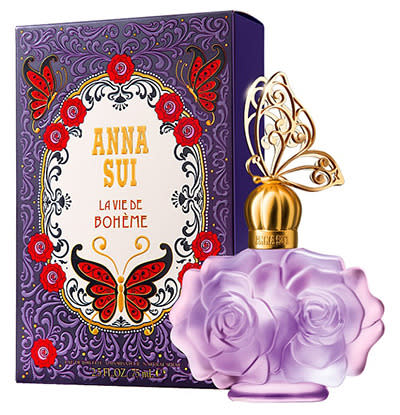Why The Beauty Industry Needs to Get Serious About Green Packaging

Cosmetic product packaging prioritizes aesthetics. (Photo: Courtesy of Anna Sui Beauty)
Because beauty companies know better than anyone that a healthy glow starts within, they’re increasingly using non-toxic ingredients. They’ve obviously tapped into a trend since the organic and natural products market is expected to top $15 billion by 2020. With so much interest in products’ ingredients, it makes sense to wonder about packaging as well. Many companies now advertise on their labels that the materials used in their bottles and boxes are both recycled and recyclable. But what really makes packaging eco-friendly? And given that the average American produces about three pounds of trash per person daily — plus an estimated 71% of plastic bottles are sent to landfills are beauty companies doing enough?
For most products, standard plastic packaging is still the norm. Plastic bottles, tubes, compacts, and jars make up 61% of all types of packaging and that’s expected to grow 12% by 2019. One reason is plastic’s functionality. It’s rigid, impermeable and light, which makes it easy and affordable to ship. It also lends itself to high design, which is no small thing in a market known for its trend-setting style. Just think about the elegance of Chanel’s iconic compacts, or the whimsical vibe of Anna Sui’s makeup line. Those associations are created and defined by the products’ packaging — and beauty companies’ rely on their outer wrappings both to set them apart and draw us in.
Some industry leaders have made it part of their mandate to use packaging that is made mostly of recycled materials. All of Origins’ printed material uses recycled paper and their cartons are made from 50% Forest Stewardship Council-certified paperboard and 50% post-consumer recycled fiber, both of which are manufactured using renewable energy sources like wind and hydro power. Similarly, Alba Botanica bottles its shampoos and body washes in containers made from 100% post-consumer polyethylene terephthalate (PETE) resin, which use three quarters less water and energy to make than virgin PETE bottles. In fact, their company mandate is to “Do Beautiful” and their mission statement says they “constantly evaluate alternative packaging sources…as well as new eco-friendly packaging materials and processes as they become available. “Our goal to Do Beautiful is manifested in all of our actions, including out packaging choices,” says Sarah Galusha, Director of Marketing for Alba Botanica’s parent company The Hain Celestial Group. Another impressive example: Beautycounter’s recycled paper compacts that feature a tin dish that can be popped out for easy recycling and removable mirror that can be reused.
Other beauty lines are getting back to basics with glass bottles. “We choose glass because it doesn’t leach into or react with the substances it encases,” S.W. Basics founder Adina Grigore tells Yahoo Beauty. “It also acts as a natural barrier to bacteria and environmental changes, and can be recycled again and again yet maintain its original integrity.” All true, however glass is heavy and therefore not ideal for products that are mass-produced and shipped internationally because its weight ends up increasing a product’s carbon footprint. Are you feeling just how tricky it can be for a company to want to go green yet?
Some companies are demonstrating their commitment to green practices by seeking out new options for packaging materials. The Body Shop just announced its intention to replace 70% of its oil-based plastic packaging by 2020 with a material called AirCarbon, which is a thermoplastic material that behaves the same as traditional plastics. The big difference? AirCarbon uses methane and carbon dioxide, which would otherwise be released into the air as greenhouse gases. “It’s a misconception that sustainability has to compromise design and functionality,” explains Simon Locke, the Body Shop’s International Environmental Sustainability Manager. “There’s so much innovation happening out there that we can now have both.”
Other related, notable developments: plant-based biodegradable pouches increasingly being used by the food industry, and eco-grosgrain ribbons made out of recycled soda bottles used in packaging by design-minded companies including glassybaby. Surely it won’t be long before advances like these come to the attention of beauty companies.
But will any of these efforts actually make difference, or are they really nothing more than Band-Aids and a way for us to like we’re doing good without actually upending our existing habits? According to Alex Eaves, the creator of a documentary called REUSE! Because You Can’t Recycle the Planet, recyclables don’t always make it into recycling bins. And even if they do, they still require considerable resources to be transported, broken down and remade. The real key to change, he argues, is to reuse what already exists. “Our society believes that everything needs to be excessively and beautifully packaged,” Eaves tells Yahoo Beauty. And that won’t change, Eaves believes, until industry influencers make it cool to use less. Eaves’ final thought on the subject: “We all need to rethink our expectations regarding what’s chic and attractive — and to know that it doesn’t have to be all doom and gloom when it comes to being environmentally friendly.”
Related:
Sustain: A New Condom Brand That’s Earth-Friendly & Empowering
